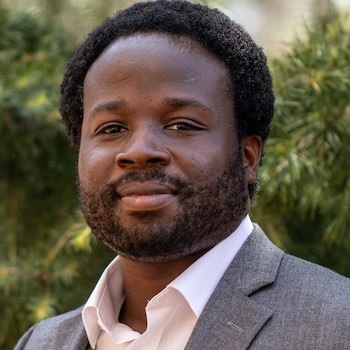Robert Gilliard, Jr.

- MIT Sponsors:
- Christopher Cummins, Department of Chemistry
- Scholar Link:Robert Gilliard, Jr. on Google Scholar
The trailblazers in human, academic, scientific and religious freedom have always been in the minority… It will take such a small committed minority to work unrelentingly to win the uncommitted majority. Such a group may transform America’s greatest dilemma into her most glorious opportunity.
Background
Robert Gilliard is an assistant professor of chemistry at the University of Virginia. He earned his doctorate in chemistry at the University of Georgia and obtained his bachelor’s degree in chemistry at Clemson University.
Interests
Gilliard’s research develops novel synthetic methods to access molecules that are important for solving problems related to environmental sustainability, energy conversion, and the discovery of next-generation electronics. He specializes in the chemical synthesis of new molecules that impact the development of new catalysts and reagents, including the discovery of unknown transformations of environmentally-relevant small-molecules (for example, carbon dioxide, carbon monoxide, and dihydrogen. In addition, Gilliard investigates the design, characterization, and reactivity of boron-based luminescent and redox-active heterocycles for use in optoelectronic applications, such as stimuli-responsive materials, thermochromic materials, and chemical sensors.
News Items
An expansive approach to making new compounds
Associate Professor Robert Gilliard and his team deploy strategies from both organic and inorganic chemistry.
Chemist and MLK Jr. Scholar Robert Gilliard explores new frontiers in synthetic chemistry
MIT visiting scholar is motivated by foundational science at the edges of the periodic table.
Meet the 2021 Class of Packard Fellows for Science and Engineering
MLK Visiting Assistant Professor Robert Gilliard, Jr. is one of twenty innovative early-career scientists and engineers in this year's Packard...
MIT welcomes nine MLK Visiting Professors and Scholars for 2021-22
Record number of honorees will engage in the life of the Institute through teaching, research, and other interactions with the MIT community.
Sample Work
Publication
A Stable, Crystalline Beryllium Radical Cation
Wang, Guocang; Walley, Jacob E.; Dickie, Diane A.; Pan, Sudip; Frenking, Gernot; Gilliard Jr., Robert J. “A Stable, Crystalline Beryllium Radical Cation” J. Am. Chem. Soc. 2020, 142, 4560-4564. DOI: 10.1021/jacs.9b13777.
Publication
Crystalline BP-Doped Phenanthryne via Photolysis of the Elusive Boraphosphaketene
Yang, W.; Krantz, K.; Freeman, Lucas A.; Dickie, Diane A.; Molino, Andrew; Wilson, David J. D.; Gilliard Jr., Robert J. “Crystalline BP-Doped Phenanthryne via Photolysis of the Elusive Boraphosphaketene” Angew. Chem. Int. Ed. 2020, 59, 3971-3975. DOI: 10.1002/anie.201916362
Publication
Persistent Borafluorene Radicals
Yang, W.; Krantz, K.; Freeman, Lucas A.; Dickie, Diane A.; Molino, Pan S.; Frenking, G.; Andrew; Wilson, David J. D.; Gilliard Jr., Robert J. “Persistent Borafluorene Radicals” Angew. Chem. Int. Ed. 2020, 59, 3850-3854. DOI: 10.1002/anie.201909627
Publication
Stable Borepinium and Borafluorenium Heterocycles: A Reversible Thermochromic "Switch" Based on Boron-Oxygen Interactions
Yang, W.; Krantz, K.; Freeman, Lucas A.; Dickie, Diane A.; Molino, Andrew; Aishvaryadeep, K.; Wilson, David J. D.; Gilliard Jr., Robert J. “Stable Borepinium and Borafluorenium Heterocycles: A Reversible Thermochromic “Switch” Based on Boron-Oxygen Interactions” Chem.−Eur. J. 2019, 25, 12512-12516. DOI: 10.1002/chem.201903348

